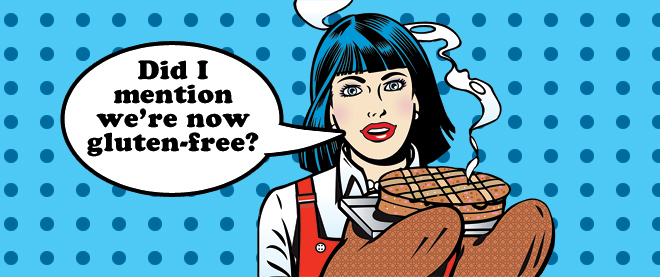The fine print on gluten-free packaged foods
Read the label: some of the products are just as bad–or worse–than processed goods
Wheat and Gluten Free
Share
These days, who’s not gluten-free?
Any dinner party, or trip to the supermarket, will confirm that in North America today, gluten is to 2012 what carbs were to the diet conscious ten years ago.
Naturopaths recommend that patients avoid the gluten protein, found in wheat and barley, to improve intestinal health. Bestselling books, such as Wheat Belly, tout not only the digestive benefits of living without gluten but the weight loss advantage it offers too. Others credit a gluten-free diet with improving all sorts of conditions including autism and ADD. And thin yet beautiful and healthy-looking Hollywood celebrities, such as Rachel Weisz, appear to be living proof of its benefits.
For the one per cent of the population who has Celiac Disease, a condition whereby gluten causes serious damage to the intestines, a gluten-free diet can be life saving. For others, it is a choice. While some people have gluten sensitivities and can’t tolerate the protein, others simply report feeling better on the diet.
“We call it the health issue of the day,” said Harry Balzer, chief industry analyst and vice president of The NPD Group who tracks American food and diet trends for market research. Their surveys started to pick up the gluten-free trend in 2009 and it has exploded since then. “We are close to 28 per cent of the adult population trying to cut out or remove gluten from their diet,” he said. “That’s more than there are active dieters in America right now.”
Five years ago, you would have been hard-pressed to find someone who knew what gluten was. Now everything is made gluten-free—muffins, bread, pizza, pretzels, breakfast cereal, crackers, cinnamon buns—and it’s all available at the supermarket. Gluten-free sales are a rapidly growing segment of the food market in North America and even companies who made their fortunes selling gluten are offering new products catering to the gluten-free.
But replacing gluten with these packaged foods is not the ticket to good health, said Meghan Telpner, a nutritionist and author of the upcoming book Undiet: How to Eat Your Way to Vibrant Health. “They’ve added in gluten-like additives like soy lecithin—these emulsifying agents that help things to be sticky and gooey to mimic gluten,” she said. “When you start to look at the ingredients, this isn’t food.”
Indeed, to read the ingredient list of gluten free packaged goods can sound more like a chemistry textbook than lunch: cellulose gum, glucono delta lactone, sodium carboxy methylcellulose. “They can cause as much harm as gluten itself,” said Telpner of the food additives and gums that processors use to make their gluten free products mimic, as best they can, the chewiness and lightness that gluten has offered bakers ever since wheat was domesticated 10,000 years ago.
And it’s not only weird-sounding ingredients that are common in gluten-free products. “It blows my mind that there can be so much sugar and fat,” said Lesia Kohut, a pastry chef and owner of the Toronto gluten-free bakery LPK’s Culinary Groove where she specializes in products made with high quality ingredients. (The store is going out of business next month due to the high cost of the organic and fair trade foods she uses.) “There’s so much crap available to people because that’s what they are used to eating,” she said.
It’s true, these products can have an ingredient list that is just as bad as any other processed food, but if people are looking for health in a bag of gluten-free pretzels, they’re not going to find it.
In fact, gluten-free on a label can mean as little as a marketing ploy. A number of companies are advertising the gluten-free nature of what they are selling—even if it never had gluten. “I saw it on a cranberry juice,” said Balzer. “Could [gluten] come from the cranberries? Not really.” These labels are an attempt at capturing the public’s interest in the convenience of buying pre-made foods that also happen to be free from gluten.
That’s not to say that a gluten-free diet can only be assembled with processed food products. In fact, said Telpner, you can find good health by going gluten-free if you eat whole foods. She suggests reading the ingredient lists before purchasing any product and if you can’t buy each ingredient at the supermarket yourself, choose something else made with real food, which can be just as tasty as any gluten-based meal.
Tobias Pohl-Weary is the chef and owner of Red Canoe Bistro in Burlington where he makes high end food, much of it without gluten. His son has an anaphylactic reaction to wheat and barley, which has made him particularly attuned to a gluten-free diet. “You need to accept that you are not going to eat the food you were eating before. But that doesn’t mean it won’t be good food,” he said. “It probably looks different but you can make some exciting items that can be enjoyed.”
